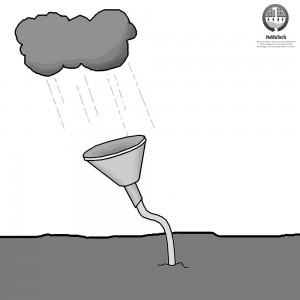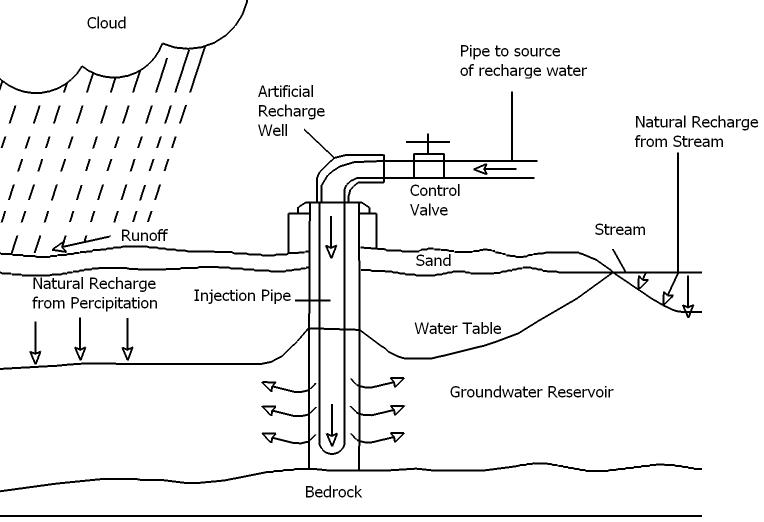Artificial subsurface groundwater recharge is a process to capture lost water due to runoff and evaporation in the areas where groundwater supplies are depleted. Long-term withdrawal exceeds long term recharge, which has led to the depletion of the groundwater level. In such regions it is required to recharge the groundwater through engineered systems. The groundwater recharge methods are broadly classified into surface and subsurface methods. When the impervious layers overlie deeper aquifers, the infiltration from surface cannot recharge the subsurface aquifer under natural conditions. The techniques adopted to recharge the confined aquifers directly from surface water source are grouped under subsurface recharge techniques.
The different sub-surface groundwater recharge techniques include injection well, gravity head recharge wells, connector wells, recharge pits and recharge shafts. The design considerations for different types of subsurface recharge depend on the type of techniques to be implemented. Injection wells are structures similar to tube well but with the purpose of augmenting the groundwater storage of a confined aquifer by pumping in treated surface water under pressure. The design and construction of an injection well is similar to a tube well. Similar to tube wells, dug wells can also be used for subsurface recharge. The connector wells are special type of recharge wells, which connect two aquifers and the recharge takes place because of potentiometer head. The designing parameters depend on the quantity of water to be recharged and the rate of recharge to the ground water (CGWR 1984).
Periodic maintenance of the system consists of pumping and / or flushing with a mildly acidic solution to remove encrusting chemical precipitates and bacterial growths on the well tube slots. By converting the injection or connector wells into dual purpose wells, the time interval between one cleansing and another can be extended, but in case of spreading structures annual desilting is necessary.
The initial cost of the artificial subsurface groundwater recharge is higher due for the construction of the wells. The cost depends on the depth of the aquifer and the integrity of rock structure. Large discharges and lower lift heads makes it an economic options even if the initial capital cost is higher. The maintenance cost depends on the treatment and the frequency of desilting and declogging of the wells.
Subsurface recharge of groundwater is carried out through injection wells. A high degree of pre-treatment is needed in the case of injection wells as water is directly injected into the groundwater. Injection wells have been extensively studied in Israel, Australia and several states of the US including California, Florida, Oregon and Arizona (BOUWER 2002). These studies provide significant data on the capability and reliability of advanced wastewater treatment processes to remove microbiological and chemical constituents, ground water quality, and monitoring techniques. Injection wells have been constructed in limestone, fractured rock and alluvial aquifers. Water used for injection is usually given tertiary treatment (sand filtration and chlorination). However, clogging still occurs when this water is used for groundwater recharge. Therefore, geochemical factors (carbonate precipitation, iron hydroxide formation, mobilisation of mineral chemicals) must be considered. Membrane filtration of treatment of the water is effective in preventing well clogging. Alternatively, injection wells are pumped using a submersible pump, once or twice a day to prevent serious clogging, which has been shown to be more effective than using membrane filtration (DILLON et al. 1997).
The use of injection wells for recharge of groundwater in India is largely experimental and is not used at a large scale anywhere. Studies have been carried out in alluvial or hard rock with confined aquifer to a depth of 40 m depth. Studies of artificial recharge have been carried out in Punjab and Gujarat, using canal water as the primary surface water source (NDWM 1989). The natural, gravity-controlled recharge rate was 5.1 L/sec. Over time, the reproducible recharge rate obtained using the pressure injection system was found to be about 10 times greater than the rate obtained using gravity flow. Clogging of interstitial spaces within the aquifer also occurs.
Studies show that recharge rates increase with increase in recharge head. On the other hand, recharge rate is higher for wells constructed in the saturated zone as compared to the vadose zone. This is because of a higher proportion of coarse sand mixed with gravel in the former. pH values are found to decrease. However, there is no reduction in MPN and COD through subsurface recharge. Studies have also been carried out in the Saraswati River basin to study ambient flows in injection wells (KUMAR et al. 2008; KUMAR & AIYAGARI 1997).
Groundwater Recharge Using Waters of Impaired Quality
The National Research's Council's Committee on Ground Water Recharge was established to study issues associated with the recharge of ground water using source waters of impaired quality, specifically treated municipal wastewater, stormwater runoff, and irrigation return flow, and issues associated with the use of recovered recharge water for potable as well as nonpotable purposes.
CGWR (1994): Groundwater Recharge Using Waters of Impaired Quality. Washington D.C.: Committee on Ground Water Recharge (CGWR), Water Science and Technology Board, Commission on Geosciences, Environment and Resources. The National Academies Press URL [Accessed: 27.05.2015]Artificial Recharge of Groundwater: Hydrogeology and Engineering
Artificial recharge of groundwater is achieved by putting surface water in basins, furrows, ditches, or other facilities where it infiltrates into the soil and moves downward to recharge aquifers. Artificial recharge is increasingly used for short- or long-term underground storage, where it has several advantages over surface storage, and in water reuse. Artificial recharge requires permeable surface soils. Where these are not available, trenches or shafts in the unsaturated zone can be used, or water can be directly injected into aquifers through wells
BOUWER, H. (2002): Artificial Recharge of Groundwater: Hydrogeology and Engineering. In: Journal of Hydrogeology: Volume 10 , 121-142. URL [Accessed: 27.05.2015]Aquifer Storage and Recovery of Stormwater Runoff
Performance Evaluation of Injection Wells for Groundwater Recharge
The study was conducted to determine the performance of injection wells for groundwater recharge using surface runoff with respect to its groundwater recharging potential and impact on groundwater quality.
KUMAR, A. ; JOSHI, H. ; KUMAR, P. (2008): Performance Evaluation of Injection Wells for Groundwater Recharge. In: Journal of Agricultural Engineering: Volume 45 URL [Accessed: 27.05.2015]Artificial Recharge of Groundwater
Compendium of Natural Water Systems and Treatment Technologies to cope with Water Shortages in Urbanised Areas in India
The Compendium of NaWaTech Technologies presents appropriate water and wastewater technologies that could enable the sustainable water management in Indian cities. It is intended as a reference for water professionals in charge of planning, designing and implementing sustainable water systems in the Indian urban scenario, based on a decentralised approach.
BARRETO DILLON, L. ; DOYLE, L. ; LANGERGRABER, G. ; SATISH, S. ; POPHALI, G. (2013): Compendium of Natural Water Systems and Treatment Technologies to cope with Water Shortages in Urbanised Areas in India. Berlin: EPUBLI GMBH URL [Accessed: 11.12.2015]http://www.nawatech.net/
This is the official webpage of the NaWaTech Collaborative Project, containing all key information related to the different case studies, activities and results of the project.




